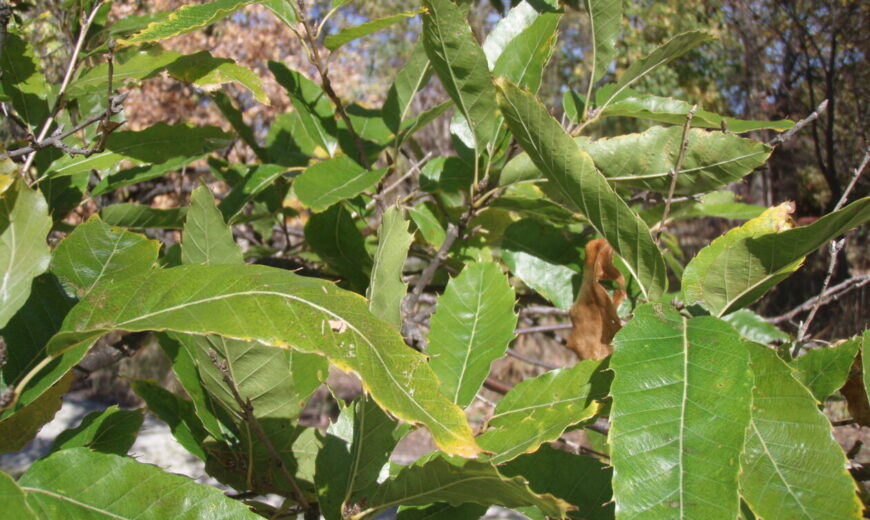Remember the Sesame Street ditty, “One of These Things Is Not Like the Others?” It seems like at one time or another, every cast member—Big Bird, Kermit, Grover, even Mr. Hooper—took a turn singing this song, which encourages kids to spot the one different object in a group.
I remember thinking I was a little old (seven, for heavens sake) for Sesame Street when it debuted in 1969. But my little brother watched it. And apparently that vicarious exposure was enough. Because just the other day, after working for the St. Charles Park District a mere three-plus years, I noticed something in our Native Plant Garden that isn’t like the others.
Okay, to be honest, it was a team effort. Our nature programs supervisor, Lauren Kulinski, had brought in a twig with green leaves to feed to our walking stick insects. Which in itself isn’t unusual; that’s what the little bugs eat, and that’s what Lauren’s been doing since last spring when the leaves popped out.
But something about this green-leafed twig struck us as odd. Wait for it…wait for it…
Shazam! The flash of inspiration was almost blinding: These leaves are green!
The ol’ wheels really started cranking then. It’s almost November. All the other leaves have turned red, yellow or brown. What tree to we have in the garden that would still be green now?
Clearly, this thing was not like the others.
What ensued was a naturalist department frenzy. We flipped through field guides. We clicked through web sites. We scratched our heads and scrunched up our faces. And, after many frustrating minutes, we had to admit it. We were stumped.
It was time to call in the experts.
We first turned to Joan Kramer, who is intimately acquainted with each and every plant in the garden. Except, as it turns out, for this one.
She went to her files, which go back 15 years and more, to consult the original garden maps. “Our” tree, back then, was labeled “Quercus imbricata?” but clearly, this thing was not a shingle oak. Subsequent plans referred to the tree as “?” or, my favorite, “______.”
Joan scrunched up her face too—not a good sign. We all vowed to continue looking into this thing that was not like the others, this thing that Lauren was now calling the bane of her existence, and went back to more pressing matters. For about 15 minutes.
That’s when John Wessel popped his head in to say hi. What timing! John’s one of our assistant superintendants, and a landscape architect. Surely he’d know what our thing was.
John examined the leaves and also the buds. He looked at the lenticels on the twig. He Googled. And then he, too, scrunched up his face.
Nuts.
It was time to call in the really big guns.
Valerie Blaine, nature programs manager at the Kane County Forest Preserve District, was next on our list. A dendrology, or tree i.d., expert with a master’s in forestry, Valerie is our ace when it comes to anything with bark. She arrived in efficient fashion and examined leaves, buds, lenticels and, I think, molecular structure, with a hand lens. She went outside and looked at the bark and branches. She stepped back, took one last look and…scrunched up her face.
Alas, that’s pretty much where things stand today. Well, we’re maybe not as scrunched, but nonetheless still puzzled by this thing that’s not like the others.
Here’s what we do know: We believe the tree to be a member of the family Fagaceae, which includes beech, oak and chestnut trees. And we know for certain that the leaves are still green—which may be our biggest clue of all.
You see, woody plant species native to northern Illinois are not green at this time of year. It’s a rule that has few exceptions. Pretty much everything you see that’s green right now in our natural areas is stuff that’s targeted for removal. Eurasian honeysuckle and European buckthorn are two examples; multiflora rose, from Japan, is another. All are just as green today as they were last spring when they first leafed out.
So, getting back to our “thing,” we’re now thinking it’s a tree from somewhere other than North America. It was purchased and planted before Pottawatomie’s Native Plant Garden had come to be the icon it is today—a showcase of plants native not just to Illinois but specifically to Kane County. It’s a tree that, in Sesame Street terms, doesn’t belong. But it’s also of decent size and has so far been well behaved—that is, neither messy nor invasive.
We’re going to keep trying to identify it, and hopefully will settle on a decision sometime in the near future. Luckily, we’ve got some time, because the tree isn’t going anywhere. That’s right, it’s going to stay. Even if it’s not like the others.
Pam Otto is the manager of nature programs and interpretive services for the St. Charles Park District. She can be reached at potto@stcparks.org or 630-513-4346.

